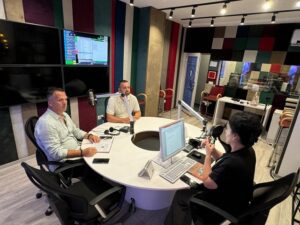The World Bank has published its latest report on the economy in the Europe and Central Asia region.
According to this report, Kosovo’s economy experienced a strong recovery in 2021, supported by a resurgence of domestic demand and record export growth.
It further states that inflation has also intensified, driven by rising import prices.
However, based on these estimates, economic growth is expected to slow to 3.9 percent in 2022.
The medium-term outlook remains positive, but affected by the increased risks, with significant increases in inflationary pressures from the war in Ukraine.
Further reforms to increase competitiveness would help maintain Kosovo’s export momentum, among other things.
This report also specifies the challenges that Kosovo faced during 2021 regarding the economic and financial issue.
Kosovo’s GDP (Gross Domestic Product) increased by 9.1 percent in 2021 after shrinking by 5.3 percent in 2020.
GDP growth is expected to reach 3.9 percent in 2022, but there are significant risks.
By the second quarter of 2021, vaccination is said to have accelerated and travel resumed, boosting economic activity. But consumption and exports of diaspora-led services remain key drivers of growth.
Private investment contributes more and more, but consists mainly of construction, with limited productivity outflows.
Positively, commodity exports rose sharply from pre-pandemic levels and, yet still low, are an encouraging sign of private sector growth.
The trade deficit, however, remains high, the report said.
The report also specifies the low labor force participation, especially for women.
“Women’s employment increased by 14 percent, but still only 16 percent of adult women were employed in the first quarter of 2021. Positively, formal employment increased throughout 2021.”
Another challenge is the increase in energy costs, as it is stated ‘putting pressure on public finances since the end of 2021, given the vulnerability of the outdated power generation infrastructure’.
In this report of the World Bank, there is also an increase in loans, remittances and foreign direct investment, with a fiscal of 3.2 percent of GDP in 2020,.
This according to the report restored confidence and increased domestic demand, bringing an extraordinary real output of 9.1 percent growth in 2021.
Significant trade growth is also specified, however it is said that agriculture contributed negatively to the growth.
According to the 2021 application platform, labor force participation, employment increased only for women (especially under the age of 25) while there is little decrease for men. However, registered employment in taxes increased by almost 10 percent during 2021.
Poverty is estimated to have decreased by about 4 percentage points in 2021 to below 20 percent.
Consumer price inflation jumped from 0.2 percent in 2020 to 3.4 percent in 2021, reaching 7.5 percent in February 2022.
Import prices of energy, food and goods spurred inflation.
Manufacturing exports increased by almost 70 percent year on year.
Exports of services more than doubled from diaspora travel recovered in 2021, while remittances also increased by 26 percent year-on-year.
Food and energy inflation can disproportionately affect the most vulnerable households, as the items cost them large budget shares. Also, rising electricity costs could increase fiscal pressures.









Your point of view caught my eye and was very interesting. Thanks. I have a question for you. https://www.binance.info/sv/join?ref=OMM3XK51
Your article helped me a lot, is there any more related content? Thanks!
Can you be more specific about the content of your article? After reading it, I still have some doubts. Hope you can help me.
Thanks for sharing. I read many of your blog posts, cool, your blog is very good.
Thank you for your sharing. I am worried that I lack creative ideas. It is your article that makes me full of hope. Thank you. But, I have a question, can you help me?